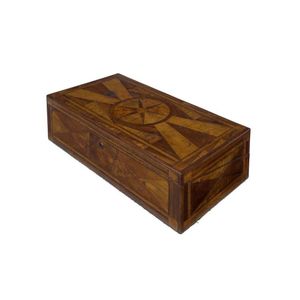1850 Tasmanian Deed Box by Richard Dowling
You must be a subscriber, and be logged in to view price and dealer details.
Subscribe Now to view actual auction price for this item
When you subscribe, you have the option of setting the currency in which to display prices to $Au, $US, $NZ or Stg.
- Blackwood - One of the best known and most widely used Australian timbers, blackwood (acacia melanoxylon), is a member of the Acacia (wattle) family and grows in eastern Australia from about Adelaide in South Australia, as far north as Cairns in Queensland.
The largest, straightest and tallest trees come from the wet forest and swamps of north-west Tasmania where it is grown commercially.
Blackwood timber colours range across a wide spectrum, from a very pale honey colour through to a dark chocolate with streaks of red tinge.
The hardwood timber has been commonly used in the production of furniture, flooring, and musical instruments in Australia from the late 19th century. However, the straight grain timber is not the most prized or valuable, that honour falls to blackwood with a wavy, fiddleback pattern, which is used both in the solid and as a veneer. Fiddleback was only used on the finest examples of furniture. - Attributed - A cataloguing term where the item in the opinion of the cataloguers, is a of the period of the artist, craftsman or designer, and which probably in whole or part is the work of that person.
- Huon Pine - Named after the Frenchman who discovered the Huon River in Tasmania, it is an extremely slow growing and long living tree. Huon pine is native to Tasmania, and it can grow to an age of 3,000 years or more. The wood contains oil that retards the growth of fungi, hence its early popularity in ship-building in convict-era Tasmania. The timber is a warm yellow colour, finely grained, and was popular for household furniture in the Victorian era. Interestingly, much Huon pine furniture was made in South Australia. Huon pine is a protected species and only limited quantities are available nowadays, for craftsmen to manufacture small items such as platters, sculptures and other decorative objects.
- Circa - A Latin term meaning 'about', often used in the antique trade to give an approximate date for the piece, usually considered to be five years on either side of the circa year. Thus, circa 1900 means the piece was made about 1900, probably between 1895 and 1905. The expression is sometimes abbreviated to c.1900.
This item has been included into following indexes:
- boxes, function - deeds and document boxes 103
- boxes, material or decoration
- Dowling, Richard (Australia) - wooden boxes 4
Visually similar items

An ebony inlaid huon pine sewing box, Tasmanian, circa 1860, 12.5 cm high, 15 cm wide, 24.5 cm deep. Literature: Australian Furniture: Pictorial History and Dictionary, 1788-1938, Kevin Fahy and Andrew Simpson, Casuarina Press Ptd Ltd, Woollahra plate 80 (

A magnificent, very large Anton Seuffert parquetry writing slope made of various New Zealand inlaid timbers. The top inlaid with a large fern surrounded by Maori motifs and a geometric band. One of very few pieces known to incorporate Maori motifs which in

A superb Tasmanian timber writing box, huon pine, musk, cedar, blackwood, myrtle, beefwood, honeysuckle and casuarina, cedar secondary timbers, fitted with slope and drawer compartments, circa 1850, 18 cm high, 61 cm wide, 31 cm deep

A Victorian walnut writing box, with rosewood and satinwood inlay and stringing, opening to a fitted interior with a leather inset writing surface, 30 cm wide, 24 cm deep, 14 cm high
